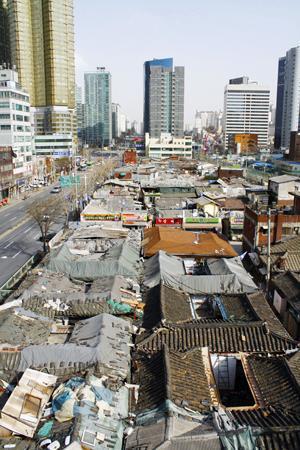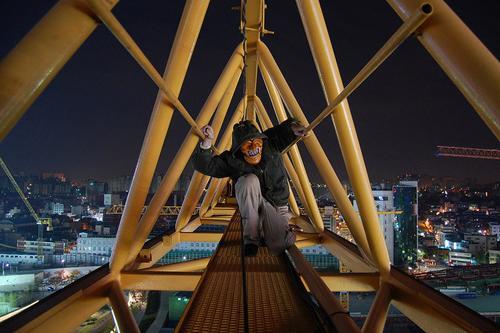
For the last eight years since his arrival in Seoul, Yangban Tal, a 33-year-old writer and photographer, has been leading the urban exploration community throughout Korea.
At the heart of it is his ongoing photo series featuring traditional Korean masks, which commoners used to mock the aristocracy, juxtaposed with urban decline across the country. He also organizes meet-ups and connects with other artists and explorers across the country.
On a sunny Sunday afternoon he brings a lone Australian with him. They both request anonymity, fearing retribution if they are caught breaking trespassing laws. After making sure the coast is clear, they crouch into the busted frame of a small home.
The inside looks like the scene of a crime. Kitchen mirrors lay shattered on the floor; drawers are pulled out and turned upside down; and floorboards sink under the weight of so much as a pinky toe.

“Gangsters have been through,” says Yangban Tal. “You can always tell by how much damage has been done to make a place unlivable.”
The small cluster of traditional homes near Gongdeok Station in western Seoul have been designated for demolition to make way for redevelopment. What was once a quaint little village bustling with life is now crumbling and marked for death with red spray paint.
Places like this are a dream for urban exploration hobbyists.
“You get to see a side of the city that nobody else really does,” he said, pulling on his mask and setting up a shot with the rundown hanoks as a backdrop. “All of these places are worthy of their own story.”
This little block of buildings is no exception. The visibly lower-class housing was probably built right after the war, says Yangban Tal. The community likely fell behind on renovations after news of their impending eviction.
Now the area is being demolished along with the construction of the new Gyeongui Line, which will open a stop at Gongdeok Station scheduled for the end of 2012. To make way for construction the citizens have been forced out.
Many of the houses show signs of rushed exits. While Yangban Tal sets up another shot inside the bedroom of one home, the Australian digs through an old office space. The desk and drawers still remain and are full of old belongings: a collection of CDs, DVDs and other nick-knacks.
“When there is this much stuff left behind, it’s a good sign that the people left in a hurry,” said Yangban Tal.
It’s a story that is played out all over the city and Yangban Tal has seen the aftermath time and time again.
On another weekend afternoon he visits the old red-light district near Yongsan Station along with a well-known blogger and a small crew of English teachers. Like Yangban Tal they ask that their real names be withheld to avoid any problems over trespassing laws.
“It’s a fun way to explore the city,” says the blogger, who has gone on previous trips with Yangban Tal. “Everyone talks about development in Korea, but this is a tangible way to see it and to see what it means for people.”
Most of the area has been turned to rubble, save for a few remaining structures. Construction workers and demolition crew have replaced prostitutes and sex workers. With all the supervision it’s difficult to sneak in anywhere and they are soon shooed away by a suspicious worker.
That’s all part of the thrill of urban exploration, though.
“You know that feeling you get when you watch a horror movie at night?” asked Yangban Tal. “That’s what it’s like sometimes when you finally get to sneak into these places. There’s an excitement and thrill to it.”
But there’s also an artistic aspect.
“I got into it originally for the adventure,” he said. “But eventually I started to think my photos could be making a difference politically. People are free to read certain messages into my work, which I think are pretty undeniable.”
It’s not always well received, though. After publishing a series on abandoned amusement parks he received a cease-and-desist request asking him to take the photos down, fearing that they would make Korea look bad. He’s not the only one to have received such requests.
Kanghee Grandas-Rhee, an artist and urban explorer of a different type, started the Danginri project, borrowing the name from a district power plant. The project is a collective photo series about the power plant, which has been a focal point of city elections.
Some of the artists involved in the project have been received requests to take their photos down.
“My friend took a picture of this plant at night with the steam coming out and he uploaded it to the Internet,” said Grandas-Rhee.
“He got a call from city hall saying that it looked like pollution, even though it’s not, and they asked him to delete it.”
In addition to using the empty urban spaces in his photography, Grandas-Rhee has found new purposes for them, using them for events, parties, and art projects.
He’s currently collaborating with several other artists on the DoHa project, spearheaded by singer-songwriter Halim. Over the next year they will convert the abandoned DoHa Korean military base into a living work of art. Artists from across the city will move into a few of the abandoned office buildings on the base and convert them into art exhibitions.
“There is still one year before construction begins,” said Halim. “So it’s a kind of charm that after one year, our art project will be gone. We will come then disappear.”
Work on the main building where the artists’ offices will be held has already begun and a makeshift yard has been built in the back. Halim hopes to gain momentum by this summer.
“Every city is made beautiful by its artists,” said Halim. “But Seoul doesn’t have a good balance. Hongdae used to be that but now it’s being taken over by big companies. I hope this project will bring back a kind of balance.”
Though Yangban Tal typically loses interest in a place once people start actively using it, he says he looks forward to working with the DoHa project. He sees these projects as a step forward for the urban development in the city.
“There is so much redevelopment in Seoul and so much space wasted,” he said. “I think the Korean people’s eyes are just starting to open up to the urban renewal process, and projects like this are taking definitive steps in changing how Korean society will interact with its spaces in the future.”
(Yonhap News)
-
Articles by Korea Herald








![[KH Explains] How should Korea adjust its trade defenses against Chinese EVs?](http://res.heraldm.com/phpwas/restmb_idxmake.php?idx=644&simg=/content/image/2024/04/15/20240415050562_0.jpg&u=20240415144419)











![[Today’s K-pop] Stray Kids to return soon: report](http://res.heraldm.com/phpwas/restmb_idxmake.php?idx=642&simg=/content/image/2024/04/16/20240416050713_0.jpg&u=)